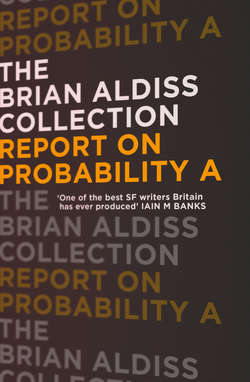Читать книгу Report on Probability A - Brian Aldiss - Страница 10
Chapter Five
ОглавлениеThe inside of the old brick building was large enough to house a private carriage such as prosperous people drove in the days before automobiles were invented. The floor space was partly filled by a bench along the right-hand wall; several old oil drums that stood along the rear wall; a motor-driven lawn mower and a miscellany of garden tools that stood or leaned along the left-hand wall; and a number of boxes, broken pieces of furniture, a tin trunk with the initials ‘H.S.M.’ stencilled large upon it, a rusty bird cage, a garden roller, a kitchen mangle with a bicycle leaning against it with flat tyres, a pile of sacks, a petrol can, several lengths of copper piping, and various other oddments, all lying about the floor, chiefly at the rear or south-west end of the brick building.
Also at that end of the building was a solid wooden structure of steps leading up to the room above. S advanced to this structure and ascended the steps, placing his feet with care as well as speed, for the treads had been unevenly hollowed in the middle.
As he ascended, his head, and consequently his eyes, came level with and then rose above the floor of the upper room, a rough, splintery, and uneven floor of old planks which was streaked here and there in no particular pattern with areas of smoothness – round a knot in the wood, or along the side of a board raised slightly higher than its neighbours; these smooth parts were of a lighter yellow tone than the predominant rough areas of wood.
Walking indiscriminately over these areas, S proceeded to the front of the room in eight and a half paces, stopped, and knelt. He could now see out of the round window that was divided into nine sections. Gazing through one of these sections, S stretched out his right hand to a point where the brickwork to the right of the round window curled into a small niche; putting his hand into the niche, S brought out a telescope.
This instrument was familiar to him. He had bought it about fifteen months ago, before Mr Mary had dismissed him, from an antique dealer whose nose was peppered with small white pimples no bigger than freckles. When closed, the telescope measured some fifteen centimetres in length; it was bound in worn leather. S pulled one end of it, revealing three brass tubes which extended out of each other. On the barrel of the smallest tube, the legend 22X was engraved, signifying that the telescope was capable of magnifying objects glimpsed through it twenty-two times. At the top of the smallest tube was the eyepiece, which S now raised to his right eye. Directing the telescope to point towards the house, he closed his left eye and stared with the other through the barrel of the telescope.
He was now viewing the world through five thicknesses of glass, four consisting of the lenses in his telescope and one of the small square panels of glass that formed the centre of the nine glass segments together comprising the round window. These layers of glass lent their slight coloration to the view.
The little circle of his vision was surrounded by black. He could not examine much of the view at one time.
He extended the telescope further. A red mist swam before his staring eye. He closed the telescope slightly. The red mist acquired texture and horizontal and vertical markings. S’s circle of vision slid over the rear wall of the house; it descended; it hovered for a moment on the back door and discerned the pane of green bottle glass that served the back door as a small window; and then it moved to the left, seeing brickwork again before it alighted on the kitchen window.
This window was different from the others of the house. The other windows were wooden framed; this was a window with metal frames. The metal frame was longer than it was high and supported three sub-sections, each of which carried six panes of glass; of these three sub-sections, the middle one was a fixture, but the two on either side of it opened, and had perforated metal bars to secure them when they were open. The window on the right was open at the present, and secured on the third perforation of its metal bar.
The circle of S’s vision slid over the window, came back, and settled on its target. The blackness now eclipsed everything but a tiny portion of brickwork, a sliver of metal frame, part of the open window viewed obliquely because it projected towards the watcher, and the small section of the kitchen framed within this opening.
Within the small section of the kitchen framed in the opening, a proportion of the figure of Mr Mary’s wife was visible. Tinted slightly by the layers of glass interposed between her and the watcher’s eye, she exposed to view, covered by a blue cardigan, something more than half her body from a line drawn by the window sill about ten centimetres above her waist: of her trunk, her left breast and shoulder were clearly visible, covered by the blue cardigan, which in turn was partially covered by an apron, two strings of which ran over the shoulders; possibly because this apron had faded, or because its pattern was small and confused, its colour registered only as a blur through the telescope.
